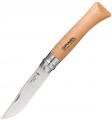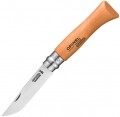Steel grade
The grade of steel from which the main blade of the knife is made. Knowing this name, you can find detailed data on the steel used and evaluate how high quality the knife is, whether it is suitable for the intended application and whether it is worth the money. Here are some of the most popular brands today:
— 440A, 440B, 440C. Category "above average". Relatively inexpensive varieties with excellent value for money. The carbon content is 0.75%, 0.9% and 1.2%, respectively; 440C steel is considered the most advanced, however, all varieties are resistant to corrosion, keep sharpening well and at the same time are quite easy to sharpen.
— AUS-8. The Japanese analogue of the "440th" line — more precisely, steel 440B (analogues 440 A and 440C are marked AUS-6 and AUS-10). It is distinguished by the presence of vanadium in the composition, which has a positive effect on wear resistance.
— 8Cr13MoV, 8Cr14MoV, 5Cr15MoV, etc. Chinese grades of steel with the addition of chromium, molybdenum and vanadium. The most popular and advanced option is deservedly considered "eight-chrome-thirteen". It is similar in properties to AUS-8, but has a higher carbon content; such steel is relatively inexpensive, but it has very good performance characteristics, due to which it is found both in relatively inexpensive knives and in premium models.
— 420. The material of the low-cost category, which, however, is distinguished by excellent corrosion resist...ance. Such steel wears out quickly, but it is also very easy to sharpen; it is well suited for low-cost knives designed for daily use.
— 420HC. A slightly more advanced version of the 420 steel described above, having a higher carbon content. As a result, the 420HC is noticeably harder and holds an edge longer; in terms of resistance to corrosion, it is practically not inferior to the original, but costs only slightly more. It is also considered an excellent option for mass-produced low-cost knives.
— D2. Category "significantly above average". A distinctive feature of this steel is its high chromium content, due to which, in terms of corrosion resistance, it approaches full-fledged “stainless steels” (although it still falls short of them). In addition, D2 is noticeably harder than most materials of a similar price category, due to which it is quite difficult to sharpen, but retains its working properties for a long time.
— CPM. A family of steels from Crucible that includes premium and super premium grades. Manufactured using the Crucible Particle Metallurgy proprietary technology, which, according to the manufacturer, provides higher quality than traditional production methods; however, such materials cost accordingly. The specific characteristics of different grades, of course, vary somewhat, but they are all characterized by good hardness and corrosion resistance. However it is worth considering that certain types of CPM (especially the most expensive ones) can be very difficult to sharpen; on the other hand, such sharpening is maintained noticeably longer than in cheaper materials.
— 65X13. Perhaps the most popular brand of Russian-made steel. It has a high chromium content, which contributes to corrosion resistance, while it is quite easy to sharpen, but does not differ in hardness. It is inexpensive and is used mainly in the mass production of inexpensive knives.
Hardness
The hardness of the material used for the knife blade. This parameter is one of the key characteristics of the blade. On the one hand, high hardness means that the cutting edge will not deform, wrinkle and dull prematurely, and the blade itself will bend under transverse loads; on the other hand, hard material is difficult to sharpen and is often rather brittle.
For knife blades, Rockwell hardness measurement and designation according to the appropriate scale (HRC) are used. Most good quality steel knives have a hardness of around 52 - 58 HRC - this range is considered to correspond to the optimal ratio of characteristics. For other materials, the numbers can be noticeably lower without any noticeable loss of reliability; see "Blade material" for details. And
hardness above 60 HRC is extremely rare - mainly in premium grade steels and higher. In such steels, the brittleness characteristic of hard materials is eliminated through the use of various high-grade additives, and the difficulty in sharpening is compensated by the blade's long service life.
It is worth remembering that hardness is not the only characteristic that determines the quality of the blade: a lot depends on the composition of the alloy, manufacturing technology, etc. However, this is a fairly clear indicator that characterizes the features of a particular material; this is especially true for steel.
Blade thickness
The thickness of the knife blade at its thickest point (usually at the butt). According to this parameter, one can to some extent evaluate the strength of the blade for transverse loads: a large thickness gives an appropriate margin of safety. At the same time, one should not forget that the “endurance” of a knife as a whole depends on many other features of its design, and only blades made of materials similar in properties can be compared in thickness. But what this indicator directly affects is the weight of the product.
Also, legal issues can be associated with the thickness of the blade, which determine whether a particular knife belongs to a cold weapon and the corresponding rules for buying, wearing and storing. The relevant rules may state, for example, that blades with a thickness of more than a certain value cannot be classified as melee weapons, regardless of other features.

